|
Part 1: First Look... |
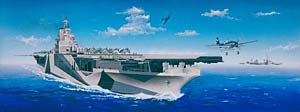 |
|
MSRP: $129.95 USD Thanks to Stevens International Importers and Distributors of Hobby Specialties, Magnolia, NJ for supplying the review kit. USS Ticonderoga CV-14 The fourth US Navy Ticonderoga was laid down as the Hancock on February 1943, but renamed Ticonderoga on May 1943, launched February 1944 and commissioned on May 1944 in a Measure 33/10a dazzle camouflage scheme. The Tico was a long-bow (clipper-bow), Essex class aircraft carrier. The bow was lengthened while building to accommodate two 40mm AA mounts in the bow, and the flight deck was shorter to improve their arcs of fire. Also, the Tico was one of two Essex class carriers to commission with a notch in the forward port flight deck that was supposed to mount a director for the port 5in guns, but instead, another 40mm gun mount was placed. The Tico arrived in the Pacific too late for action in the Battle of Leyte Gulf, but was in action in the Philippines on November 1944. Tico took two Kamikaze hits on January 21, 1945 on the forward flight deck and bridge gun director. Repaired at Puget Sound, Tico rejoined the fleet on May 1945, dressed in Measure 21 (all Navy Blue) and without the flight deck notch. Tico was put into reserve in 1947, but was later converted and re-commissioned in 1952, serving in Vietnam War. Tico was finally stricken and scrapped in 1975. The Big T earned five Battle stars during WWII and twelve during the Vietnam War. Ticonderoga represents a typical Essex class late WWII carrier that gave the US Navy its mobility and striking power. Kit Characteristics: Injected plastic (polystyrene) kit. Full hull or waterline options, with a large stand included for the full hull option. (From manufacturer): 264 parts on 14 sprues, plus decks, lower and upper hulls, waterline plate and display stand (for full hull option). Parts are sharply molded with virtually no flash, and packaged well to prevent damage during shipping. 20-page instruction booklet is in English and Japanese with pictures of each sprue and hull pieces. Exploded view drawings clearly show part numbers and their locations on the model. One tip to expedite assembly is to label the undersides of pieces with the sprue part number, and port/starboard location. This way you can put them where they belong without mistakes. Assembly looks to be straightforward if one follows the steps. Hull length scales out to 884 feet without considering the aft 40mm sponson, very close to the 888 feet actual. Hull beam (width) scales out to 94 feet, very close to the actual 93 feet. The flight deck width was difficult to measure before assembly, but also was close to actual. Thus, the proportions are accurate. Construction is by subassemblies, with hull and deck assembly followed by building the hangar deck, then adding hull platforms. Flight deck is in three pieces – fore, center and aft, about equal lengths. Considerable detail is added to the undersides, a nice touch. Bridge assembly and armament finish off the assembly. Because Essex-class carriers came in short and long bow versions, Trumpeter has elected to cast the majority of the hull common to all ships of this class, and include the appropriate bow section for each particular ship. The bow section needs to be mated to the rest of the hull, and will leave a seam that needs to be filled and sanded on curved hull sides. A poor filling and sanding job will detract from the appearance of the finished model. The front and main hull pieces did not line up well because the main hull section was flattened out, necessitating clamping during gluing. The inside of the hangar deck will be closed off by the flight deck, and the rolling shutters are molded closed, so the hangar deck interior will not be visible after assembly. However, there is sufficient detail in the hangar deck to finish it, and enterprising modelers can add more details and aircraft for those wishing to go the extra mile. The shutters could be cut out and opened, and the flight deck does not have to be glued in place if one wants to remove the flight deck to show off detail inside the hangar. Thus, this kit has many possibilities for the experienced modeler wishing to customize appearance of the ship. If the flight deck is to be glued in place, there are two seams that need to be carefully filled and sanded. Again, a poor job filling and sanding could detract from the appearance of the finished model. The flight deck detail molded on the kit pieces is excellent and very convincing for a “busy” look. Elevators can be positioned up or down. Flight deck notch confusion: when built, Ticonderoga was one of only two Essex-class carriers to be completed with a small notch in the flight deck on the port side just aft of the 5in single mounts. This was to accommodate a director for the 5in guns, and during construction, the director was cancelled, and a 40mm gun mount placed instead, but too late to modify the flight deck shape. Thus, the unaltered model does not accurately portray the Ticonderoga until her refit in 1945 after the Kamikaze hits, when the notch was filled in. After this refit, the paint scheme was changed to all blue Measure 21. The instruction sheet illustrations show the flight deck piece with the notch, but the actual piece has a smooth portion that needs to be cut out to match the ship in its 1944 guise. The instructions never say that one has to cut out the smooth notch. The instructions also show a similar notch in the rear flight deck section, which is not seen on photographs, so do not cut out this notch. One unusual feature that promises to cause additional seams to fill and sand is the use of sidings to add to the 5in turrets. This practice will leave ugly seams on the turrets that will take considerable care to fill and sand smooth. Photos of the actual ship and 5in mounts do not show these large seams on the turrets, and leaving them as is will detract from the overall look of the ship unless filled in, since the 5in turrets are very obviously located on the flight deck. Puzzling why the turrets were not cast in one piece. AA guns are numerous, and in 1/350 scale look closer to scale, compared to 1/700 kits. The 40mm mounts are not bad, but the 20mm mounts have no shields and rather thick barrels with no detail. The lack of shields for the 20mm guns is a lot easier for the modeler, but is not accurate, and a drawback to the overall appearance of the finished kit. For the modeler who wants to super-detail this kit, after-market photo etch sets from Gold Medal Models, Tom’s Modelworks, White Ensign, Eduard or Classic Warships would improve the 20mm AA armament greatly. 40mm gun pieces and rails are also available in 1/350 scale, allowing super detailing for this kit. Gold Medal Models, Tom’s Modelworks, White Ensign, Eduard or Classic Warships all make 1/350 photo etch sets for US WW2 warships that supply railings, catapults, cranes, radars, radio lattice masts, mast spiders and other small pieces for those who wish to add even more detail. A separate 11x14in Painting & Marking Guide printed in color is included. This page contains color renditions of port, starboard and overhead views of the ship in her 1944 Measure 33/10a dazzle camouflage scheme. Overhead, underside and side views of each type of aircraft are also included. The scheme illustrated looks identical to actual photographs of the ship. Paint guide lists Gunze Sanyo paints to complete the model. These paints are sometimes difficult to find in the US on hobby store shelves. The paint color descriptions in the guide do not match the well-known names of US naval ship paints used in World War 2. Snyder and Short produce color chips for US Naval paints, and several companies produce appropriate paints for this era – check with your local hobby supplier or favorite websites for matching paints. White Ensign and Floating Drydock enamels and Polly-S and Model Shipways acrylic paints closely match the official US Navy colors. 33/10a colors were: Light Gray (5-L), Ocean Gray (5-O) and Navy Blue (5-N) for vertical surfaces. Decks were Deck Blue (20-B), and the flight deck for Tico may have been the slightly lighter Flight Deck Stain (No. 21). Normal wear quickly faded flight deck stains, allowing the wood underneath to show through, so you have some options on how soon after completion you want your model to illustrate. The dashes on the flight deck were probably light gray, not white or yellow like other carriers. Five types of aircraft are provided (four of each) – Hellcats, Corsairs, Dauntlesses, Helldivers and Avengers. Each plane is a kit to itself. Wings can be positioned folded or extended. Canopies are molded in clear plastic – another nice touch. Panel lines are exaggerated, but at this scale that may help the appearance. Each plane looks fairly accurate. Trumpeter sells each type of aircraft separately for those who want to populate their kit with more aircraft. A large decal sheet is supplied with the correct black hull number (14) for the flight deck. Correct insignia and squadron markings for the air group are also included, another nice touch. However, the extensive flight deck dashes (always a nightmare for US carrier modelers) are white, and photos indicate a light gray color just after commissioning. This can be rectified by careful and painstaking dry brushing or other painting of the dashes after the decals are added.
Summary: The Trumpeter Ticonderoga CV-14 kit is large, and will take over any mantle or display case. The camouflage scheme for this carrier was striking, and is sure to be an eye-catcher. A straightforward build for this kit is forecast. One feature of 1/350 scale warships is the larger size of pieces, a boon to beginners and those with fading eyesight. On the other hand, 1/350 scale ships cry out for super detailing and photo etched parts, since they are more to scale and look realistic. The only trouble spots are filling the seams on the hull, flight deck and 5in turrets, and cutting out the flight deck notch. Also, ignore the Painting Guide and use paints from several companies that use the proper USN color designations. Out of the box, this kit will build into an impressive model, but the lack of 20mm gun shields detracts from the look and accuracy, and there are few planes supplied with the kit. Given the large amount of historical and photographic data on Essex class carriers, this feature will bother purists, but does not detract from the splendor of this kit for those who are not concerned with super detailing. References: Arnold GR. Warship Perspectives. Essex Class Aircraft Carriers in World War Two. WR Press. Campbell J. Naval Weapons of World War Two. Conway Maritime Press, London, UK, 1985. 0-85177-329-X Faltum A. The Essex Class Aircraft Carriers. Nautical & Aviation Publishing, 1996. ISBN: 1-877853-26-7 The Floating Drydock. United States Navy Camouflage 1 of the WW2 Era. Part 1. The Floating Drydock, Kresgeville, PA, 1976. ISBN: 0-944055-01-X The Floating Drydock. United States Navy Camouflage 2 of the WW2 Era. Part 2 Fleet Carriers. The Floating Drydock, Kresgeville, PA, 1976. (this book has been updated with more photos and is newly available on CD from Floating Drydock) Friedman N. U.S. Aircraft Carriers. An Illustrated Design History. Naval Institute Press, Annapolis, MD, 1983. ISBN 0-87021-739-9 Raven A. Warship Design Histories: Essex-Class Carriers. Naval institute Press , 1988. ISBN: 0-87021-021-1 Self C. The USS Hornet CV-12 - CVA-12 - CVS12. The Aircraft Carrier USS Hornet Foundation, Inc., 1995. ISBN: 1-56311-336-3 Smith M. Essex Class Carriers in Action. Warships Number 10, Squadron/Signal Publications, Carrollton, TX. ISBN: 0-89747-373-6 Terzibaschitsch S. Aircraft Carriers of the U.S. Navy, 2nd Edition. Naval Institute Press, Annapolis, MD, 1989. USS Ticonderoga CV-14 WWII-Vietnam. Turner Publications. Wiper S. USS Ticonderoga CV/CVA/CVS-14. Warship Pictorial #22, Classic Warships Publishing, 2004. ISBN 0-9745687-2-4 Websites: A Google® search will find many sites for information about the USS Pittsburgh, but my favorites are:
|
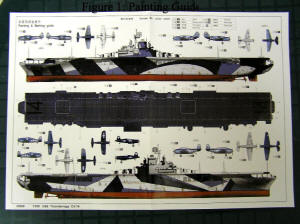 Painting Guide (color) supplied with kit showing Measure 33/10a disruptive camouflage scheme |
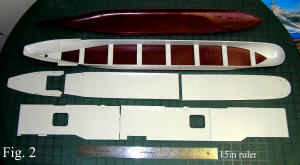 Picture of hull and flight deck pieces. Notice the 15-inch ruler in front of the pieces |
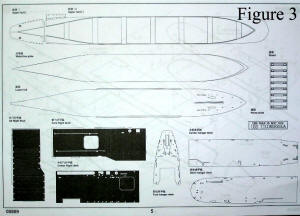 Page 5 of Instruction booklet showing flight deck and hull pieces, with the notch on the forward flight deck piece |
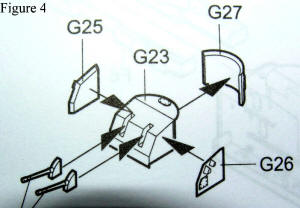 View of 5in turret assembly from instruction booklet, showing where seams will need to be filled |
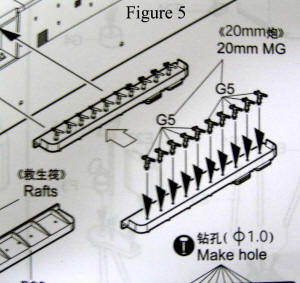 View of 20mm mounts from Instruction booklet showing lack of shields and detail |
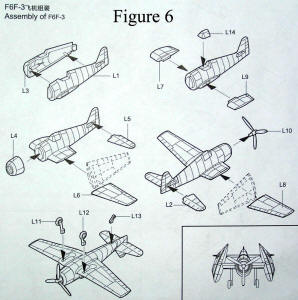 Assembly instructions for Hellcat planes, showing that each plane is a kit unto itself |
|
Information, images, and all other items placed electronically on this site are the intellectual property of IPMS/USA ®. |